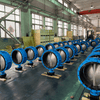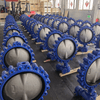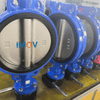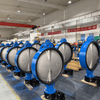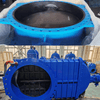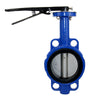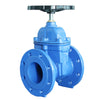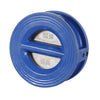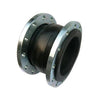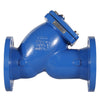Difference Between O-type Ball Valve And V-notch Ball Valve
A ball valve is a type of valve in which the closing element is a ball that rotates around the centerline of the valve body to open and close.
It operates with a 90-degree rotation, with a spherical plug that has a circular hole or passage through its axis. In pipelines, ball valves are primarily used for shutting off, distributing, or changing the flow direction of the medium. With a 90-degree rotation and a small amount of torque, the valve can be tightly sealed. Ball valves are most suitable for use as on-off or shut-off valves.
O-type and V-notch ball valves are both types of ball valves. These two types have different structures and characteristics, making them suitable for different working conditions. By analyzing their differences and features, users can better understand and select the appropriate valve for their needs.
O-Type Ball Valve Design
The O-type ball valve features a fully spherical core with a round flow passage, hence the name O-type ball valve.
Most of the ball valves we use are O-type ball valves. They have low flow resistance, and the opening and closing process only requires a 90-degree rotation of the valve core, allowing for fast operation.
When equipped with an AT pneumatic actuator, it can be used as a quick shut-off valve. With two valve seats at the inlet and outlet, it provides reliable sealing. The O-type ball valve is suitable for gases, steam, liquids, and media containing small amounts of suspended particles.

V-Notch Ball Valve Design
The V-notch ball valve is a highly efficient valve with a unique design, featuring a V-shaped opening on one side of the spherical core.
By adjusting the opening of the valve core, it can effectively change the flow area of the medium, enabling precise flow control. It can also be used for on-off control, allowing the pipeline to open or close.
This valve has a self-cleaning function and can regulate small flows within a narrow opening range, with a wide adjustable ratio. It is suitable for media containing fibers, fine particles, and slurry. It offers high reliability and stability, making it an indispensable part of fluid control systems.
1.Flow Analysis of V-Notch Ball Valves with Different Cone Angles
The cone angle of a V-notch ball valve refers to the opening angle of the sphere, typically ranging from 15° to 60°. The cone angle significantly affects the valve's flow characteristics and control performance:
Small Cone Angles (15°-30°): Suitable for fine adjustments, offering smooth flow variation. Ideal for applications requiring high adjustment accuracy.
Large Cone Angles (30°-60°): Exhibit noticeable flow characteristics, suitable for quick opening and closing, and effective for applications with high flow demands.
As the cone angle increases, the shearing force becomes stronger, making it suitable for media containing fibers or small solid particles. The choice of cone angle should be based on specific operating conditions and fluid characteristics to ensure optimal valve performance.

2.Does the V-Notch Ball Valve Have Directionality?
(1)V-notch ball valves typically have flow direction indicators on the valve body.
(2)These valves are generally designed for unidirectional sealing and have specific directional requirements. Incorrect installation can lead to poor sealing performance.
(3)V-notch ball valves are especially suitable for applications involving fibrous fluids. Due to their unidirectional sealing characteristics, they are not suitable for bidirectional use.
What Is The Difference Between O-type Ball Valve And V-notch Ball Valve?
1.Valve Core Structure:
The O-type ball valve has a fully round flow passage and is sealed with dual valve seats. The V-notch ball valve, on the other hand, has a quarter-spherical core with a V-shaped notch on one side and typically uses a single valve seat. There are also versions with a fully spherical core, with a V-shaped flow passage on one end, and they can use either single or dual valve seat seals.
2.Suitable Media:
O-type ball valves are mainly used for clean media or media with small amounts of suspended particles. When sealed with PTFE (Teflon) valve seats, they can achieve zero leakage. However, when the media contains more impurities or particles, the valve cavity can easily become clogged, causing the valve to seize and malfunction.
V-notch ball valves, usually with metal hard seals, are used for media containing fibers, fine particles, and slurries. The V-shaped notch can shear through fibrous media, making them widely used in the paper industry. The partial-spherical core and single valve seat design effectively prevent clogging.
3.Process Control Requirements:
O-type ball valves are mainly used for on-off control and are not well suited for flow regulation. When equipped with an AT pneumatic piston actuator, they can be used for rapid shutoff. V-notch ball valves, with their V-shaped notch, offer good adjustability and a wide adjustable ratio, up to 100:1 or more. They are mainly used for flow regulation when equipped with pneumatic or electric actuators, but can also be used for on-off control.
4.Flow Characteristics:
O-type ball valves have a "quick-open" flow characteristic, making them suitable for on-off control. V-notch ball valves have an approximately equal-percentage flow characteristic, making them more suitable for flow regulation.
5.Flow Passage Size:
O-type ball valves generally come in full-bore or reduced-bore sizes. V-notch ball valve flow passages vary according to process and design requirements, and are typically reduced-bore. Different ball cores can be used to meet various flow needs.
Advantages and Disadvantages of V-Notch Ball Valves
V-notch ball valves are known for their excellent sealing performance, low fluid resistance, and flexible operation. Their V-shaped cut design allows for quick opening and closing, reducing the impact of fluid on the ball, which minimizes noise and vibration.
Additionally, these valves enable flow regulation with high adjustment accuracy, making them ideal for applications requiring precise control of flow and pressure in industrial settings.
However, V-notch ball valves also have some drawbacks.Firstly, their complex structure results in relatively high manufacturing costs.Secondly, their lifespan can be affected in harsh conditions such as high temperature and high pressure.
Moreover, the friction between the ball and the seat can lead to wear, impacting both sealing performance and adjustment accuracy. Therefore, when selecting a V-notch ball valve, it is important to consider the specific application environment and requirements.
In summary, V-notch ball valves are suitable for precise flow regulation and quick opening and closing, while O-ball valves are better suited for complete opening or sealing applications. For more information, please contact Union Valve, a professional valve manufacturer in China.
Related Article:
- Which is better for a globe valve: low inlet, high outlet or high inlet, low outlet?
- What Is The Difference Between Wedge-Type Gate Valve And Slab Gate Valve?
- Characteristics of Resilient Seated Gate Valve and Their Differences from Metal Sealing Gate Valves
- Understanding Butterfly Valve Seats: The Differences Between Hard, Soft and Rubber Lined

-
Posted in
Ball Valve, O-type Ball Valve, V-notch Ball Valve

